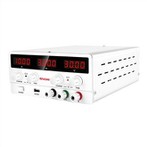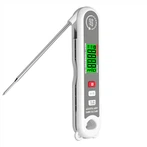Introduction and working principle of multimeter
Header
The head of the multimeter is a sensitive galvanometer. The dial on the head is printed with various symbols, scale marks and values. The symbol A-V-Ω indicates that the ammeter is a multimeter that can measure current, voltage and resistance. There are multiple scale lines printed on the dial, among which the one marked with "Ω" on the right is the resistance scale line, the right end is zero, the left end is ∞, and the scale value distribution is uneven. The symbol "-" or "DC" means direct current, "~" or "AC" means alternating current, and "~" means the scale line shared by AC and DC. Several rows of numbers under the scale line are the scale values corresponding to the different positions of the selector switch.
There is also a mechanical zero adjustment knob on the meter head to correct the zero position of the pointer at the left end.
switch
The selector switch of the multimeter is a multi-position rotary switch. Used to select measurement items and ranges.
General multimeter measurement items include: "mA"; DC current, "V (-)": DC voltage, "V (~)": AC voltage, "Ω": resistance. Each measurement item is divided into several different ranges for selection.
Test leads and test lead jacks
The test leads are divided into red and black. When in use, insert the red test lead into the jack marked "+", and insert the black test lead into the jack marked "-".
Head (pointer type)
It is a high-sensitivity magnetoelectric DC ammeter, and the main performance indicators of the multimeter basically depend on the performance of the meter head. The sensitivity of the meter head refers to the DC current value flowing through the meter head when the pointer of the meter head is deflected at full scale. The smaller the value, the higher the sensitivity of the meter head. The greater the internal resistance when measuring voltage, the better its performance. There are four scale lines on the meter head, and their functions are as follows: The first line (from top to bottom) is marked with R or Ω, which indicates the resistance value. When the switch is in the ohm block, read this scale line. ** The bar is marked with ∽ and VA, indicating the AC, DC voltage and DC current value. When the transfer switch is in the AC, DC voltage or DC current position, and the range is in a position other than AC 10V, read this scale Wire. The third line is marked with 10V, which indicates the AC voltage value of 10V. When the switch is in the AC and DC voltage range and the range is at AC 10V, read this scale line. The fourth bar, labeled dB, indicates the audio level.
Meter (digital)
The head of a digital multimeter generally consists of an A/D (analog/digital) conversion chip + peripheral components + liquid crystal display.
The accuracy of the multimeter is affected by the head of the meter. The multimeter is generally called a 3 1/2-digit digital multimeter, a 4 1/2-digit digital multimeter, etc. due to the number converted by the A/D chip. *The commonly used chips are ICL7106 (classic chip with 3.5-digit LCD manual range, the subsequent versions are 7106A, 7106B, 7206, 7240, etc.), ICL7129 (classic chip with 4.5-digit LCD manual range), ICL7107 (3-digit and a half LED manual range Classic chip).
measuring line
The measurement circuit is a circuit used to convert various measured objects into a small DC current suitable for meter measurement. It consists of resistors, semiconductor components and batteries.
It can convert various measured objects (such as current, voltage, resistance, etc.) and different ranges into a certain amount of tiny DC current through a series of processing (such as rectification, shunting, voltage division, etc.) gauge to measure.
transfer switch
Its function is to select a variety of different measurement lines to meet the measurement requirements of different types and ranges. The transfer switch is generally a circular dial with function and range marked around it.
working principle
The basic principle of the multimeter is to use a sensitive magnetoelectric DC ammeter (microampere meter) as the meter head.
When a small current passes through the meter head, there will be a current indication. However, the meter head cannot pass a large current, so some resistors must be connected in parallel or in series on the meter head to shunt or lower the voltage, so as to measure the current, voltage and resistance in the circuit.
design principle
The measurement process of the digital multimeter converts the measured value into a DC voltage signal by the conversion circuit, and then converts the voltage analog quantity into a digital quantity by the analog/digital (A/D) converter, then counts through the electronic counter, and finally uses the measurement result with The numbers are shown directly on the display.
The function of the multimeter to measure voltage, current and resistance is realized through the conversion circuit part, and the measurement of current and resistance is based on the measurement of voltage, that is to say, the digital multimeter is expanded on the basis of the digital DC voltmeter.
The A/D converter of the digital DC voltmeter converts the analog voltage quantity that changes continuously with time into a digital quantity, and then the digital quantity is counted by the electronic counter to obtain the measurement result, and then the measurement result is displayed by the decoding display circuit. The logic control circuit controls the coordinated work of the circuit, and completes the entire measurement process in sequence under the action of the clock.






